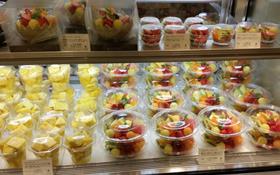
An ageing population, growing demand for convenient food and the weakening yen has driven Japan’s household fruit consumption to a 14-year low.
Consumption of fruit dropped to 76.05kg per household in 2016, while expenditure hit a ten-year high of ¥36,845 (US$329.4) per household, according to statistics released by Japan’s Ministry of Finance.
“To some extent, this can be attributedto the weakening of the Japanese yen resulting in prices in 2016 up 115 per cent, which was a reason for a decline in consumption to 90.3 per cent of the level in 2015,” explained Jack Moriya, president of leading importer Tokyo Seika.
“Among otherfactors would be anageing population living ona fixedincome, dietary changes, evolving consumption trends, especially with the younger generation where there is a strong demandfor convenience.”
Moriya said the demand for convenient produce was demonstrated in the drop in grapefruit consumption, which fell from 4.49kg per household in 2004 to 0.98kg per Japanese household consumption in 2016.
“While the purchase price of grapefruit in 2016 was the highest ever at ¥340 (US$3.04) per kilogram, theoverriding reason for the decline is one of convenience.
'Fresh fruits have also been faced with heavy competition from juices and yoghurts as they are conveniently packaged and appealing to the younger generation,” he said.
Bananas remain the leading fruit import in Japan, though household consumption in 2016 fell to its third-lowest in 14 years to 17.96kg, with the purchasing price reaching a record high at ¥277 (US$2.48) per kg. Consumption peaked in 2009 with 23.08kg of bananas consumed per household.
Consumption of kiwifruit has continued to grow, reaching 2.01kg per household in 2016, the highest since kiwifruit consumption records began being recorded in 2012.
“This trend could be misleading as consumptionof kiwifruit is still small compared to other fresh fruits,” Moriya said.“Household expenditure for kiwifruit was also the highestever at ¥1,629 (US$14.56), while the purchase price was thesecond highest ever at ¥826 (US$7.38) per kilogram.The question remains whether or not the price for kiwifruit is elastic or inelastic.
“As with other fresh fruit, there is an introduction period followed by growth in consumption, then at some point the market reaches maturity, plateaus, then starts to decline for whatever reason,' he continued. “Maintaining theright price point in the marketplace for Japanese consumers will be the key to sustaining a growing market.”



